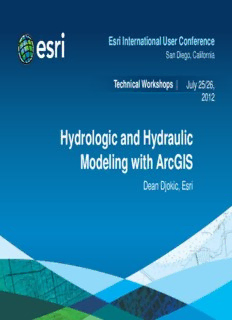
Hydrologic and Hydraulic Modeling with ArcGIS PDF
Preview Hydrologic and Hydraulic Modeling with ArcGIS
Esri International User Conference San Diego, California Technical Workshops | July 25/26, 2012 Hydrologic and Hydraulic Modeling with ArcGIS Dean Djokic, Esri Overview Core GIS tools for surface water analysis • DEM data and processing • - Demo Application tools for Hydrologic and Hydraulic Modeling • Q&A • 2 Water Resources Issues Not enough (droughts) • Too much (floods) • Of wrong kind (water quality) • In a wrong place (spatial distribution) • At the wrong time (temporal distribution) • 3 Focus on Surface Water Quantity How much water is there? • - Hydrologic modeling (precipitation-runoff modeling), determines for a given storm on a landscape, how much water will become runoff. Where will it go? • - Hydraulic modeling takes the quantity of water and the shape of the landscape and stream channel and determines how deep and fast the water will be, and what area it will cover in the event of a flood. 4 Hydrologic Modeling Q Goal: Find stream discharge, , at a location for a given • precipitation event. There are many ways to calculate Q. • - Statistical methods - USGS regression equations (NFF, StreamStats) - “Physical” modeling (rainfall-runoff models) - HEC-HMS, SMS, etc. GIS is used to summarize terrain and hydrologic • characteristics of the watershed for input to a model. 5 Hydrologic Modeling Map natural processes onto software tasks. • Aggregate landscape characteristics and define the • layout. - “Lumped parameter model” 6 Hydraulic Modeling Goal: Predict water surface elevations to create flood • inundation maps. - Also predict velocity, sedimentation, quality Input: Channel and floodplain geometry with hydraulic • characteristics, plus discharge ‘Q’ and initial water surface level. Output: Water surface elevation at each cross section • and other characteristics. GIS is used to summarize terrain and hydraulic • characteristics of the channel for input to a model and post process hydraulic modeling results (surface determination). 7 GIS Data for Hydrologic and Hydraulic Modeling Digital Elevation Model and land cover • - http://seamless.usgs.gov/ - http://edna.usgs.gov/ - http://www.horizon-systems.com/nhdplus/ Watershed boundaries • - http://www.ncgc.nrcs.usda.gov/products/datasets/waters hed/ Hydrography • - http://nhd.usgs.gov/ Soils • - http://www.soils.usda.gov/survey/geography/statsgo/ 8 GIS Data for Hydrologic and Hydraulic Modeling Current and historic water records • - http://waterdata.usgs.gov/nwis - http://www.epa.gov/STORET/index.html - http://his.cuahsi.org/ Climate and precipitation • - http://www.weather.gov/gis/ - http://www.ncdc.noaa.gov/oa/ncdc.html Channel geometry (cross sections) • 9 Drainage System Watershed (Basin, Catchment, Watershed Boundaries Contributing area) (Drainage Divides) Pour Points (Outlets) 10
Description: